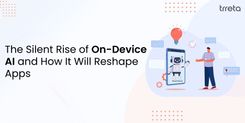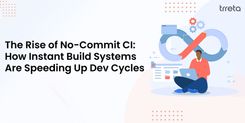If you have been in and around the tech world, you would know that SaaS isn’t just a tech trend; it’s the backbone of modern business models across industries.
In plain terms, SaaS (software as a service) means delivering software over the internet instead of installing it on a local machine. It’s a shift from one-time purchases to ongoing subscriptions, enabling businesses to access powerful tools without the hassle of maintenance, hardware, or expensive licenses.
So, whether you’re in healthcare, real estate, finance, or education, SaaS has changed how products are built, sold, and scaled.
In this guide, we will break down saas application development step by step, so you can plan, build, and grow a successful SaaS platform with confidence (or outsource it to the best agency that has years of experience doing this - Trreta).
Let’s first begin by understanding what SaaS is.
What Is SaaS (Software as a Service)?

If you’re new to the idea, let us tell you that SaaS is a business model where software is hosted in the cloud and accessed via a web browser or app.
With this feature, instead of buying a CD or downloading an installer, your customers simply log in online.
And unlike traditional software, SaaS allows:
- Continuous updates without manual installs.
- Subscription-based pricing, turning large upfront costs into predictable monthly fees.
- Accessibility from any device, anywhere.
You may see it written as sass software as a service, but don’t worry, it’s the same thing.
To give you examples of some of the most famous saas applications, we can say they include -
- Slack, for team messaging.
- HubSpot, for marketing and sales.
- Salesforce, for CRM and enterprise sales.
All of these and many other SaaS solutions available in the market prove that SaaS isn’t just software; it’s a way to build services that grow with your customers.
Now that you know what SaaS is but have you ever wondered why SaaS is the future? Why do businesses and end users love SaaS so much?
Let’s find that out in the following section.
Why SaaS Is the Future for Modern Businesses?

The simple reason why so many businesses are moving towards SaaS is that it has some of the best advantages to offer, as mentioned below -
- Predictable recurring revenue: Subscriptions help you forecast earnings and scale sustainably.
- Scalability and global reach: With a cloud infrastructure facility, you can serve millions of customers worldwide.
- Lower upfront costs for customers: You can attract a lot more new users who prefer paying monthly instead of huge one-time fees.
- Fit all niches: Whether you are in accounting for freelancers or compliance tools for banks, SaaS enables targeted, vertical solutions for every business.
In a nutshell, for founders, the SaaS model reduces risk, rewards customer retention, and opens opportunities to innovate faster.
6 Types of SaaS Applications (and Their Business Model)

Before you start building your SaaS platform, here is some important information you need to know about SaaS application types, and based on this information, you can have better clarity of what kind of SaaS application you want to build.
1. Horizontal SaaS: Broad tools serving many industries (e.g., Slack).
2. Vertical SaaS: Platforms solving industry-specific problems, like CRMs for dental clinics or inventory apps for restaurants.
3. B2B SaaS: Software sold to businesses, usually offering collaboration, automation, or analytics.
4. B2C SaaS: Apps sold directly to individual consumers, like fitness tracking or budgeting tools.
5. Internal SaaS tools: Custom productivity apps used inside large enterprises.
6. Productized services: Agencies turning repeatable services into SaaS. For example, client dashboards or reporting portals.
Now, based on your expertise and future business plans, you can go for the best SaaS product development that best suits your requirements.
Other than the types of SaaS applications, you also need to consider that the lifecycle of SaaS application development is equally important.
What is the SaaS Application Development Lifecycle?
Building a successful SaaS platform involves more than writing code.
Here’s the typical process for SaaS application development:

1. Market research & validation:
The first step is to talk to your target audience. You need to double-check their pain points and willingness to pay.
2. Product strategy & feature roadmap:
Once the market research is done, you need to make a list of must-have features vs. nice-to-have features to make the application appealing to the target market.
3. UI/UX design:
Moving next is crafting an intuitive, simple design that matches the preferences and behaviours of your target audience to reduce churn.
4. Frontend + backend development:
After finalizing on UI/UX design, it’s time to build your SaaS platform using chosen frameworks and technologies.
5. Testing and QA:
The next step includes checking for bugs and usability issues before the platform goes live.
6. Launch:
Finally, when everything is tried and tested, it’s time to deploy your app and onboard your first customers.
7. Iteration:
And once the launch is done, it’s time to gather feedback, improve features, and adapt as your users grow.
Now, while building this SaaS application, you need to keep in mind that there are some features that are non-negotiable.
Let’s have a look at those as we move further!
5 Must-Have Features in a Scalable SaaS Product
No matter for which niche and industry you are looking for saas application development solutions, here are the features it should include -

1. User management & authentication:
Secure logins, password resets, and account management.
2. Subscription & billing system:
Integrate Stripe, PayPal, or other payment providers to manage recurring charges.
3. Role-based access control:
Allow different permissions for admins, users, and guests.
4. Analytics & dashboards:
Provide actionable insights to users and your team.
5. Cloud scalability & APIs:
Make sure your app can handle growing traffic and integrations with other tools.
When you have all of these features included in your SaaS application development, they set a foundation for a reliable platform capable of scaling in the future.
How to Choose the Right Tech Stack for SaaS Development?

There’s no doubt that your tech stack can make or break your SaaS product.
Picking the right combination of frameworks, databases, and cloud services affects everything from speed to long-term maintainability.
Here’s what many successful SaaS application development services teams use:
- Frontend frameworks: React, Vue, or Angular for responsive interfaces.
- Backend frameworks: Node.js, Laravel, Django, depending on language and team strengths.
- Databases: PostgreSQL or MongoDB, chosen based on data structure and scaling needs.
- Cloud providers: AWS, Google Cloud, or Azure for global performance, storage, and security.
Want to find what makes deliver the best SaaS application development services? Talk to our team today to find out!
What is the Cost of Developing a SaaS Application? (Non-Technical, Founder-Focused)

Now let’s talk about the elephant in the room.
Here’s what founders should know when planning to develop SaaS application projects -
- Features & complexity: The more functionality, integrations, and user roles, the higher the cost.
- Team size: Hiring senior developers, designers, and product managers increases expenses.
- Timeline: Fast-tracking a launch requires more resources, which can inflate costs.
Typical costs:
- MVPs: $50,000–$150,000.
- Full-featured platforms: $200,000–$500,000+ depending on scale.
Want to get exact pricing based on your requirements? Inquire today!
What are Some SaaS Security & Compliance Considerations to Keep in Mind?

When it comes to SaaS, security is placed on high stakes and for obvious reasons.
Here’s what every founder should plan for security in SaaS application development services -
- Encryption: Keep data safe in transit and at rest.
- User permissions: Limit what users can see and do.
- Audit logs: Track actions to spot misuse or breaches.
- Compliance standards: GDPR (data privacy), HIPAA (healthcare), and SOC 2 (data security) can be legally required depending on the industry.
Remember, when you ignore even anyone of this, it can destroy customer trust, and even get you fined.
What Should You Do Post-Launch - Growth, Support, and Scaling the SaaS Product

In SaaS, the work doesn’t end after launch; it just begins after it!
Here’s what you all need to do once you have launched the app/platform -
- Customer onboarding & retention: First impressions matter. Guide users to value quickly.
- Feedback loops & updates: Regularly collect feedback and improve features to match evolving needs.
- Infrastructure scaling: Use tools like Kubernetes or serverless architectures to handle user growth.
- Support: Decide whether to build an in-house support team or partner with a service provider.
Get The Best SaaS Application Development Services from Trreta
Building a successful SaaS product is more about understanding your market, solving real problems, and scaling with confidence than just a few lines of code.
And that’s where experience makes all the difference.
At Trreta, we guide startups and growing businesses like yours through every stage of SaaS application development - from discovery workshops and UX design to full-stack engineering, cloud deployment, and scaling strategies.
Looking to build or scale your next SaaS product? Our team offers end-to-end saas application development solutions to help you succeed faster.
FAQs
Q1. What is SaaS (software as a service)?
It’s a model where software is delivered over the internet, letting customers access apps via browsers or apps on a subscription basis.
Q2. How long does SaaS application development take?
It really depends, but generally, 3 - 6 months for an MVP and 9 to 18 months for fully featured platforms based on the complexity and team resources.
Q3. What industries benefit most from SaaS products?
Nearly every industry: healthcare, finance, education, retail, and niche B2B sectors can all benefit from scalable SaaS solutions.
Q4. What’s the cost to develop a SaaS application?
MVPs typically cost $50,000–$150,000, while full-scale products range from $200,000 upwards.
Q5. What are the biggest mistakes to avoid in SaaS development?
Some of the mistakes that you should avoid are skipping market validation, underestimating security needs, poor onboarding, and not planning for scalability.





